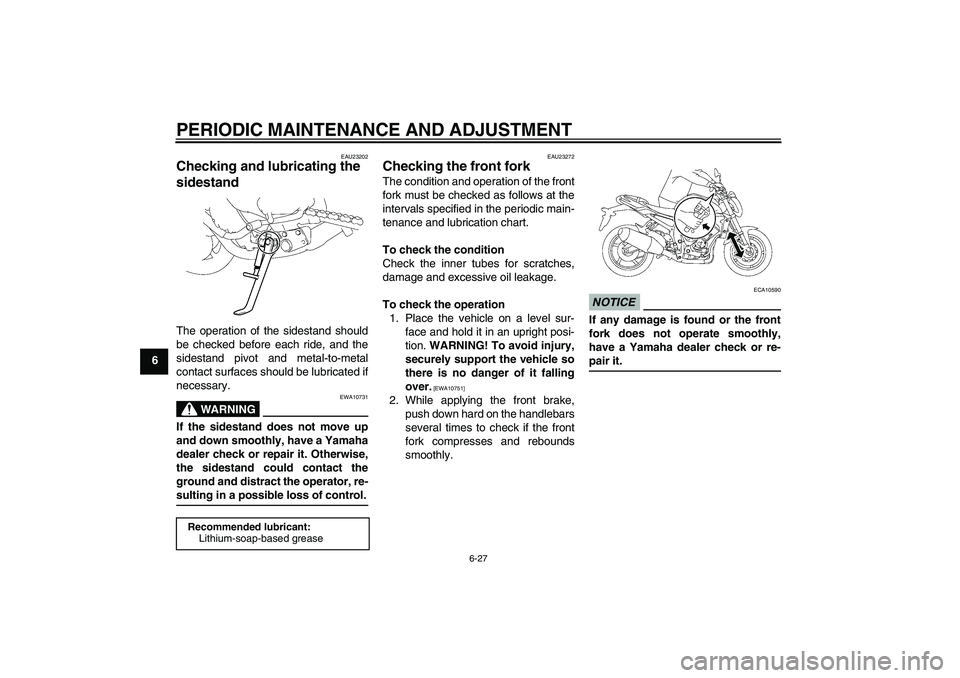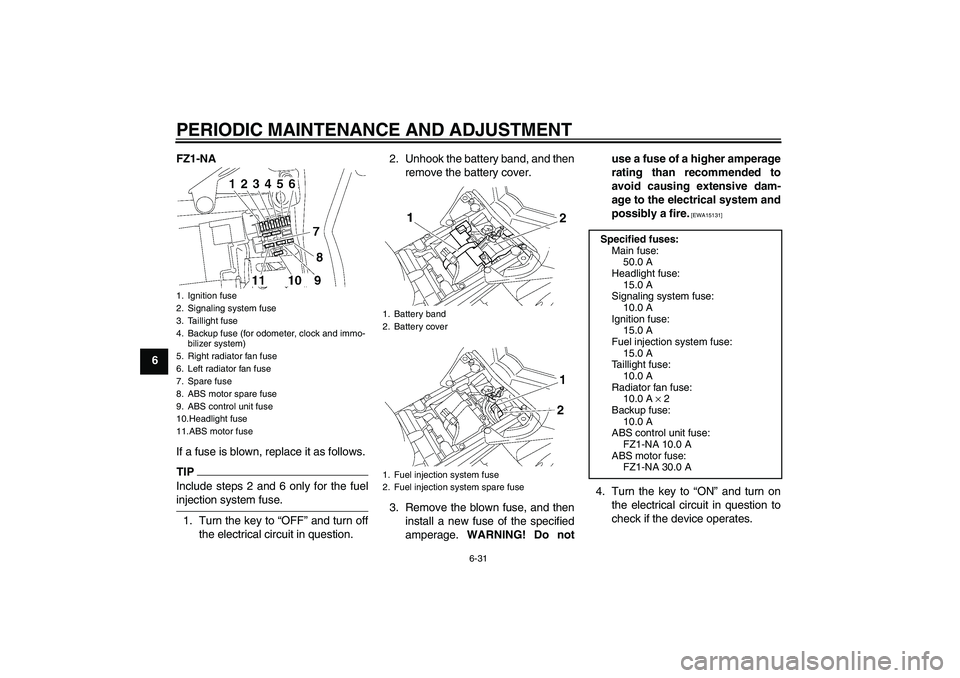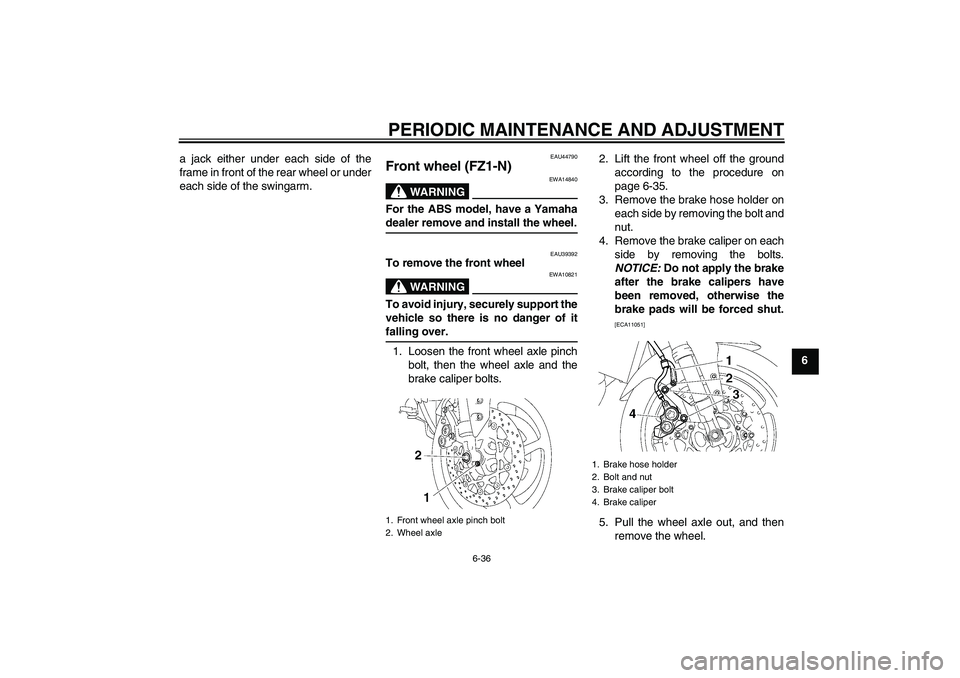Page 74 of 104

PERIODIC MAINTENANCE AND ADJUSTMENT
6-25
6
EAU23101
Checking and lubricating the
cables The operation of all control cables and
the condition of the cables should be
checked before each ride, and the ca-
bles and cable ends should be lubricat-
ed if necessary. If a cable is damaged
or does not move smoothly, have a
Yamaha dealer check or replace it.
WARNING! Damage to the outer
sheath may interfere with proper ca-
ble operation and will cause the in-
ner cable to rust. Replace a
damaged cable as soon as possible
to prevent unsafe conditions.
[EWA10721]EAU23111
Checking and lubricating the
throttle grip and cable The operation of the throttle grip should
be checked before each ride. In addi-
tion, the cable should be lubricated at
the intervals specified in the periodic
maintenance chart.
EAU44271
Checking and lubricating the
brake and shift pedals The operation of the brake and shift
pedals should be checked before each
ride, and the pedal pivots should be lu-
bricated if necessary.
Recommended lubricant:
Engine oil
U2D1E3E0.book Page 25 Monday, July 14, 2008 3:08 PM
Page 76 of 104

PERIODIC MAINTENANCE AND ADJUSTMENT
6-27
6
EAU23202
Checking and lubricating the
sidestand The operation of the sidestand should
be checked before each ride, and the
sidestand pivot and metal-to-metal
contact surfaces should be lubricated if
necessary.
WARNING
EWA10731
If the sidestand does not move up
and down smoothly, have a Yamaha
dealer check or repair it. Otherwise,
the sidestand could contact the
ground and distract the operator, re-sulting in a possible loss of control.
EAU23272
Checking the front fork The condition and operation of the front
fork must be checked as follows at the
intervals specified in the periodic main-
tenance and lubrication chart.
To check the condition
Check the inner tubes for scratches,
damage and excessive oil leakage.
To check the operation
1. Place the vehicle on a level sur-
face and hold it in an upright posi-
tion. WARNING! To avoid injury,
securely support the vehicle so
there is no danger of it falling
over.
[EWA10751]
2. While applying the front brake,
push down hard on the handlebars
several times to check if the front
fork compresses and rebounds
smoothly.
NOTICE
ECA10590
If any damage is found or the front
fork does not operate smoothly,
have a Yamaha dealer check or re-pair it.
Recommended lubricant:
Lithium-soap-based grease
U2D1E3E0.book Page 27 Monday, July 14, 2008 3:08 PM
Page 77 of 104

PERIODIC MAINTENANCE AND ADJUSTMENT
6-28
6
EAU23283
Checking the steering Worn or loose steering bearings may
cause danger. Therefore, the operation
of the steering must be checked as fol-
lows at the intervals specified in the pe-
riodic maintenance and lubrication
chart.
1. Place a stand under the engine to
raise the front wheel off the
ground. (See page 6-35 for more
information.) WARNING! To
avoid injury, securely support
the vehicle so there is no danger
of it falling over.
[EWA10751]
2. Hold the lower ends of the front
fork legs and try to move them for-
ward and backward. If any free
play can be felt, have a Yamaha
dealer check or repair the steering.
EAU23290
Checking the wheel bearings The front and rear wheel bearings must
be checked at the intervals specified in
the periodic maintenance and lubrica-
tion chart. If there is play in the wheel
hub or if the wheel does not turn
smoothly, have a Yamaha dealer check
the wheel bearings.
EAU33654
Battery This model is equipped with a VRLA
(Valve Regulated Lead Acid) battery.
There is no need to check the electro-
lyte or to add distilled water. However,
the battery lead connections need to be
checked and, if necessary, tightened.
WARNING
EWA10760
�
Electrolyte is poisonous and
dangerous since it contains sul-
furic acid, which causes severe
burns. Avoid any contact with
skin, eyes or clothing and al-
ways shield your eyes when
1. Positive battery lead (red)
2. Negative battery lead (black)
3. Battery
U2D1E3E0.book Page 28 Monday, July 14, 2008 3:08 PM
Page 80 of 104

PERIODIC MAINTENANCE AND ADJUSTMENT
6-31
6FZ1-NA
If a fuse is blown, replace it as follows.
TIPInclude steps 2 and 6 only for the fuelinjection system fuse.
1. Turn the key to “OFF” and turn off
the electrical circuit in question.2. Unhook the battery band, and then
remove the battery cover.
3. Remove the blown fuse, and then
install a new fuse of the specified
amperage. WARNING! Do notuse a fuse of a higher amperage
rating than recommended to
avoid causing extensive dam-
age to the electrical system and
possibly a fire.
[EWA15131]
4. Turn the key to “ON” and turn on
the electrical circuit in question to
check if the device operates.
1. Ignition fuse
2. Signaling system fuse
3. Taillight fuse
4. Backup fuse (for odometer, clock and immo-
bilizer system)
5. Right radiator fan fuse
6. Left radiator fan fuse
7. Spare fuse
8. ABS motor spare fuse
9. ABS control unit fuse
10.Headlight fuse
11.ABS motor fuse
1. Battery band
2. Battery cover
1. Fuel injection system fuse
2. Fuel injection system spare fuse
Specified fuses:
Main fuse:
50.0 A
Headlight fuse:
15.0 A
Signaling system fuse:
10.0 A
Ignition fuse:
15.0 A
Fuel injection system fuse:
15.0 A
Taillight fuse:
10.0 A
Radiator fan fuse:
10.0 A × 2
Backup fuse:
10.0 A
ABS control unit fuse:
FZ1-NA 10.0 A
ABS motor fuse:
FZ1-NA 30.0 A
U2D1E3E0.book Page 31 Monday, July 14, 2008 3:08 PM
Page 85 of 104

PERIODIC MAINTENANCE AND ADJUSTMENT
6-36
6 a jack either under each side of the
frame in front of the rear wheel or under
each side of the swingarm.
EAU44790
Front wheel (FZ1-N)
WARNING
EWA14840
For the ABS model, have a Yamahadealer remove and install the wheel.
EAU39392
To remove the front wheel
WARNING
EWA10821
To avoid injury, securely support the
vehicle so there is no danger of itfalling over.
1. Loosen the front wheel axle pinch
bolt, then the wheel axle and the
brake caliper bolts.2. Lift the front wheel off the ground
according to the procedure on
page 6-35.
3. Remove the brake hose holder on
each side by removing the bolt and
nut.
4. Remove the brake caliper on each
side by removing the bolts.
NOTICE: Do not apply the brake
after the brake calipers have
been removed, otherwise the
brake pads will be forced shut.
[ECA11051]
5. Pull the wheel axle out, and then
remove the wheel.
1. Front wheel axle pinch bolt
2. Wheel axle
1. Brake hose holder
2. Bolt and nut
3. Brake caliper bolt
4. Brake caliper
U2D1E3E0.book Page 36 Monday, July 14, 2008 3:08 PM
Page 86 of 104

PERIODIC MAINTENANCE AND ADJUSTMENT
6-37
6
EAU39400
To install the front wheel
1. Lift the wheel up between the fork
legs.
2. Insert the wheel axle.
3. Lower the front wheel so that it is
on the ground.
4. Install the brake calipers by install-
ing the bolts.TIPMake sure that there is enough space
between the brake pads before install-
ing the brake calipers onto the brakediscs.
5. Install the brake hose holders by
installing the bolt and nut.
6. Tighten the wheel axle, the wheel
axle pinch bolt and the brake cali-
per bolts to the specified torques.7. Push down hard on the handlebar
several times to check for proper
fork operation.
EAU44800
Rear wheel (FZ1-N)
WARNING
EWA14840
For the ABS model, have a Yamahadealer remove and install the wheel.
EAU25312
To remove the rear wheel
WARNING
EWA10821
To avoid injury, securely support the
vehicle so there is no danger of itfalling over.
1. Loosen the axle nut.
Tightening torques:
Wheel axle:
72 Nm (7.2 m·kgf, 52 ft·lbf)
Front wheel axle pinch bolt:
23 Nm (2.3 m·kgf, 17 ft·lbf)
Brake caliper bolt:
40 Nm (4.0 m·kgf, 29 ft·lbf)
1. Axle nut
2. Locknut
3. Drive chain slack adjusting bolt
4. Brake caliper
5. Brake caliper bracket
U2D1E3E0.book Page 37 Monday, July 14, 2008 3:08 PM
Page 88 of 104

PERIODIC MAINTENANCE AND ADJUSTMENT
6-39
6
EAU25871
Troubleshooting Although Yamaha motorcycles receive
a thorough inspection before shipment
from the factory, trouble may occur dur-
ing operation. Any problem in the fuel,
compression, or ignition systems, for
example, can cause poor starting and
loss of power.
The following troubleshooting charts
represent quick and easy procedures
for checking these vital systems your-
self. However, should your motorcycle
require any repair, take it to a Yamaha
dealer, whose skilled technicians have
the necessary tools, experience, and
know-how to service the motorcycle
properly.
Use only genuine Yamaha replace-
ment parts. Imitation parts may look like
Yamaha parts, but they are often inferi-
or, have a shorter service life and can
lead to expensive repair bills.
WARNING
EWA15141
When checking the fuel system, do
not smoke, and make sure there are
no open flames or sparks in the ar-
ea, including pilot lights from waterheaters or furnaces. Gasoline or
gasoline vapors can ignite or ex-
plode, causing severe injury or
property damage.
U2D1E3E0.book Page 39 Monday, July 14, 2008 3:08 PM
Page 90 of 104

PERIODIC MAINTENANCE AND ADJUSTMENT
6-41
6Engine overheating
WARNING
EWAT1040
�
Do not remove the radiator cap when the engine and radiator are hot. Scalding hot fluid and steam may be
blown out under pressure, which could cause serious injury. Be sure to wait until the engine has cooled.
�
Place a thick rag, like a towel, over the radiator cap, and then slowly rotate the cap counterclockwise to the de-
tent to allow any residual pressure to escape. When the hissing sound has stopped, press down on the capwhile turning it counterclockwise, and then remove the cap.
TIPIf coolant is not available, tap water can be temporarily used instead, provided that it is changed to the recommended coolantas soon as possible.
Wait until the
engine has cooled.
Check the coolant level in the
reservoir and radiator.
The coolant level
is OK.The coolant level is low.
Check the cooling system
for leakage.
Have a Yamaha dealer checkand repair the cooling system.Add coolant. (See TIP.)
Start the engine. If the engine overheats again,
have a
Yamaha dealer check
and repair the cooling system.
There is
leakage.
There is
no leakage.
U2D1E3E0.book Page 41 Monday, July 14, 2008 3:08 PM